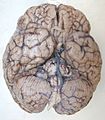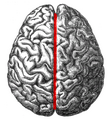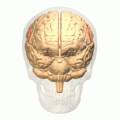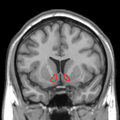Difference between revisions of "Neuroanatomy"
Jump to navigation
Jump to search
(→Less important: +images) |
Jensflorian (talk | contribs) (+added pictures and some general overview) |
||
| (7 intermediate revisions by 2 users not shown) | |||
| Line 4: | Line 4: | ||
==Anatomy== | ==Anatomy== | ||
===General=== | |||
* Central nervous system (CNS): Brain, spinal cord. | |||
*Cortex: | |||
**Cerebral lobes: Frontal, parietal, temporal, occipital, insula. | |||
*Diencephalon: Thalamus, hypothalamus. | |||
*Mesencephalon: Colliculi (superior, inferior). | |||
*Metencephalon: Pons, cerebellum. | |||
*Myelencephalon: Medulla. | |||
*Ventricular system: | |||
**Lateral ventricles, interventricular foramen, third ventricle, cerebral aquaeduct, fourth ventricle, subrachnoid space. | |||
*Meninges: | |||
**Outer Covering, CSF circulation, buoyancy of brain. | |||
**Falx cerebri (between hemispheres), Tentorium cerebelli (separates cerebellum). | |||
<gallery> | |||
File:Brain_autopsy_top_view.jpg | Brain: Top view | |||
File:Brain_autopsy_bottom_view.jpg | Brain: Bottom view | |||
File:Brain_autopsy_lateral_view.jpg | Brain: Lateral view | |||
File:Blausen 0104 Brain x-secs SectionalPlanes.png | Orientation planes (WC/blausen staff) | |||
File:1202_White_and_Gray_Matter.jpg | Gray and white matter | |||
</gallery> | |||
===Important=== | ===Important=== | ||
*Basal ganglia | |||
**Includes: Nucleus caudatus, putamen, pallidum, subthalamus, substantia nigra | |||
**Part of the forebrain. | |||
**Caudate nucleus + putamen = striatum. | |||
**Pallidum + putamen = lenticular nucleus. | |||
<gallery> | |||
File:Blausen_0076_BasalGanglia.png | Schematic overview (WC/blausen staff) | |||
File:Basal_ganglia_1.jpg | Section with descriptions (WC/SMH) | |||
</gallery> | |||
*Uncus (as in ''uncal herniation''). | *Uncus (as in ''uncal herniation''). | ||
<gallery> | |||
File:Uncus_animation_small.gif | Position of the uncus | |||
File:Slide2cuc.JPG | Uncus bottom view (WC/Anatomist90) | |||
</gallery> | |||
*Cerebellar tonsils (as in ''tonsillar herniation''). | *Cerebellar tonsils (as in ''tonsillar herniation''). | ||
*Hippocampus (as in ''hippocampal sclerosis''). | |||
<gallery> | |||
File:Hippocampus.png | Location of the hippocampus in the brain (WC/Washington irving) | |||
File:Human temporal lobe areas.png | Hippocampus is marked blue on this coronar section (PLoS/Talbot et al.) | |||
File:Hippocampus macroscopy.jpg| Macroscopic specimen after formalin fixation showing hippocampus in coronar section (WC) | |||
</gallery> | |||
*Longitudinal fissure - divides cerebrum into hemispheres. | *Longitudinal fissure - divides cerebrum into hemispheres. | ||
<gallery> | |||
File:Longitudinal fissure of cerebrum.gif| Animation showing position of longitudinal fissure in the brain (WC) | |||
File:Human brain longitudinal fissure.png | Superior view on longitudinal fissure (WC) | |||
</gallery> | |||
*Lateral sulcus (Sylvian fissure, lateral fissure) - separates temporal lobe from frontal lobe & parietal lobe. | *Lateral sulcus (Sylvian fissure, lateral fissure) - separates temporal lobe from frontal lobe & parietal lobe. | ||
<gallery> | |||
File:Lateral sulcus.gif | Animation showing position of lateral sulcus in the brain (WC) | |||
File:Human brain lateral view description.JPG | Fixated brain, lateral view. The sulcus centralis is marked with 5 (WC) | |||
</gallery> | |||
*Central sulcus - separate ''parietal lobe'' from ''frontal lobe''. | *Central sulcus - separate ''parietal lobe'' from ''frontal lobe''. | ||
<gallery> | |||
File:Central sulcus animation.gif|Animation displaying position of central sulcus (WC) | |||
File:Central sulcus superior view.png| Superior view on central sulcus (WC) | |||
File:Human brain lateral view description.JPG | Fixated brain, lateral view. The sulcus centralis is marked with 6 (WC) | |||
</gallery> | |||
*Brain stem = medulla oblongata, pons, mesencephalon (midbrain).<ref>{{Ref Martini6|466}}</ref> | *Brain stem = medulla oblongata, pons, mesencephalon (midbrain).<ref>{{Ref Martini6|466}}</ref> | ||
<gallery> | |||
File:1311 Brain Stem.jpg | The three distinct parts of the brainstem are colored in this sagital section of a human brain (WC) | |||
File:Slide2RAFA.JPG | Anterior view on a formalin fixated brainstem (WC). | |||
File:Human brain frontal (coronal) section.JPG | Coronal section through brainstem and hemispheres (WC) | |||
</gallery> | |||
===Less important=== | ===Less important=== | ||
| Line 26: | Line 89: | ||
<gallery> | <gallery> | ||
Image:Dopamine_and_serotonin_pathways.gif NAcc - sagittal. (WC) | Image:Dopamine_and_serotonin_pathways.gif |NAcc - sagittal. (WC) | ||
Image:Nucleus_accumbens_MRI.PNG NAcc - frontal. (WC) | Image:Nucleus_accumbens_MRI.PNG |NAcc - frontal. (WC) | ||
</gallery> | </gallery> | ||
====Nucleus basalis of Meynert==== | ====Nucleus basalis of Meynert==== | ||
*Abbreviated ''NBM''. | *Abbreviated ''NBM''. | ||
| Line 63: | Line 127: | ||
**Branch off ''vertebral arteries''. | **Branch off ''vertebral arteries''. | ||
Images | ====Images==== | ||
<gallery> | |||
Image:Circle_of_Willis_en.svg | Circle of Willis. (WC) | |||
</gallery> | |||
www: | |||
*[http://library.med.utah.edu/WebPath/HISTHTML/NEURANAT/CNS334A.html Interactive schematic (utah.edu)]. | *[http://library.med.utah.edu/WebPath/HISTHTML/NEURANAT/CNS334A.html Interactive schematic (utah.edu)]. | ||
| Line 97: | Line 164: | ||
Intradural: | Intradural: | ||
* [[Meningioma]]. | * [[Meningioma]]. | ||
* | * [[Neurofibroma]]s. | ||
* Schwannoma. | * [[Schwannoma]]. | ||
* Arachnoid cyst. | * [[Arachnoid cyst]]. | ||
Extradural: | Extradural: | ||
* [[Chordoma]]. | * [[Chordoma]]. | ||
* [[Schwannoma]]. | * [[Schwannoma]]. | ||
* Sarcoma. | * [[Sarcoma]]. | ||
* Plasmacytoma. | * [[Plasmacytoma]]. | ||
* Primary bone | * Primary bone tumours - [[osteosarcoma]], osteochondroma, [[chondrosarcoma]]. | ||
* Mets (lung, breast, etc.). | * Mets (lung, breast, etc.). | ||
==Neuropathological dissection (autopsy)== | |||
Brain fixation after removal: Usually 14 days | |||
*Check brain for: | |||
** Lesions | |||
** edema (might be not visible but tissue is softer than normal) | |||
** hemorrhage | |||
** Discolorations | |||
** Asymmetry (midline shift) | |||
** herniation (subfalxial, uncal, tonsillar) | |||
** vascular abnormalities | |||
<gallery> | |||
File:MCA-Stroke-Brain-Human-2.JPG | Asymmetry (midline shift) indicating lesions (stroke, tumor) | |||
File:Brain_autopsy_hemorrhage_bottom_view.JPG | Brain hemorrhage | |||
File:Autopsy brain.jpg | Atrophy: widespread sulci, often seen in neurodegenerative diseases | |||
File:Alexander autopsy.jpg | Brown discolorations indicating demyelinisation | |||
</gallery> | |||
==Sampling - sections (autopsy)== | ==Sampling - sections (autopsy)== | ||
| Line 113: | Line 200: | ||
Standard histologic sections: | Standard histologic sections: | ||
{| class="wikitable sortable" style="margin-left:auto;margin-right:auto" | {| class="wikitable sortable" style="margin-left:auto;margin-right:auto" | ||
! '''Site''' | |||
! '''Routine'''<ref name=Ref_HospAuto164>{{Ref HospAuto|164}}}}</ref> | |||
! '''Head injury'''<ref name=Ref_HospAuto174>{{Ref HospAuto|176}}}}</ref> | |||
! '''[[Epilepsy]]'''<ref name=Ref_HospAuto179>{{Ref HospAuto|179}}}}</ref> | |||
! '''[[Dementia]]'''<ref name=Ref_HospAuto180>{{Ref HospAuto|180}}}}</ref> | |||
|- | |- | ||
| Frontal cortex | | Frontal cortex | ||
Latest revision as of 08:13, 14 April 2015
This article covers very basic neuroanatomy. It is essential to have a good grasp on neuroanatomy and neurohistology... before doing neuropathology.
This article has some overlap with the neurohistology article, as there isn't a clear divider between microscopic and macroscopic.
Anatomy
General
- Central nervous system (CNS): Brain, spinal cord.
- Cortex:
- Cerebral lobes: Frontal, parietal, temporal, occipital, insula.
- Diencephalon: Thalamus, hypothalamus.
- Mesencephalon: Colliculi (superior, inferior).
- Metencephalon: Pons, cerebellum.
- Myelencephalon: Medulla.
- Ventricular system:
- Lateral ventricles, interventricular foramen, third ventricle, cerebral aquaeduct, fourth ventricle, subrachnoid space.
- Meninges:
- Outer Covering, CSF circulation, buoyancy of brain.
- Falx cerebri (between hemispheres), Tentorium cerebelli (separates cerebellum).
Important
- Basal ganglia
- Includes: Nucleus caudatus, putamen, pallidum, subthalamus, substantia nigra
- Part of the forebrain.
- Caudate nucleus + putamen = striatum.
- Pallidum + putamen = lenticular nucleus.
- Uncus (as in uncal herniation).
- Cerebellar tonsils (as in tonsillar herniation).
- Hippocampus (as in hippocampal sclerosis).
- Longitudinal fissure - divides cerebrum into hemispheres.
- Lateral sulcus (Sylvian fissure, lateral fissure) - separates temporal lobe from frontal lobe & parietal lobe.
- Central sulcus - separate parietal lobe from frontal lobe.
- Brain stem = medulla oblongata, pons, mesencephalon (midbrain).[1]
Less important
Glomeruli of Arnold
- Over lies hippocampus.
Calcarine cortex
- Occipital lobe.
- Line of Gennari -- very thin white line in the grey matter.
- Image: Calcarine cortex (med.utah.edu) as part of CNS collection (gfmer.ch).
Nucleus accumbens
- Abbreviated NAcc - inferior-medial to where the internal capsule ends; anterior of optic chiasm.
Nucleus basalis of Meynert
- Abbreviated NBM.
- Inferior of the globus pallidus; makes acetylcholine.
Locus ceruleus
- See also: Neurohistology#Locus_ceruleus.
- Blue dots - anterior to 4th ventricle in the pons.
Images:
Other - trivia
- Claustrum - thin band of grey mater in the external capsule; function uncertain.[2]
- Nerve root vs. nerve:[3]
- Nerves have epineurium.
- Nerve roots do not have epineurium.
Notes:
- Nerve anatomy:[4]
- Nerve (surrounded by epineurium) -> Fascicle (surrounded by perineurium) -> Nerve fibre (surrounded by endoneurium).
Vascular structures
- Posterior cerebellar arteries.
- Inferior of posterior cerebral arteries.
- Anterior inferior cerebellar arteries.
- Branch off basilar artery.
- Posterior inferior cerebellar arteries - AKA PICA.
- Branch off vertebral arteries.
Images
www:
Meninges
Deep to superficial:
- Pia mater.
- Arachanoid membrane.
- Subarachanoid space - contains blood vessels.
- Dura mater.
- Tough outer covering.
Lesion location in relation to meninges
Locations:[5]
- Intra-axial = inside the (middle) of spinal cord/brain.
- AKA intramedullary.
- Intradural = not intra-axial, but deep to the dural.
- Extradural = outside of dura.
- The above descriptors are often found in radiology reports.
DDx based on location[6]
Intra-axial:[7]
- Glioma (astrocytoma, oligodendroglioma, ependymoma).
- Non-glial tumours (hemangioblastoma, CNS lymphoma).
- Metastases.
- Non-tumour:
- Abscess.
- Infarct.
- Hematoma.
Intradural:
Extradural:
- Chordoma.
- Schwannoma.
- Sarcoma.
- Plasmacytoma.
- Primary bone tumours - osteosarcoma, osteochondroma, chondrosarcoma.
- Mets (lung, breast, etc.).
Neuropathological dissection (autopsy)
Brain fixation after removal: Usually 14 days
- Check brain for:
- Lesions
- edema (might be not visible but tissue is softer than normal)
- hemorrhage
- Discolorations
- Asymmetry (midline shift)
- herniation (subfalxial, uncal, tonsillar)
- vascular abnormalities
Sampling - sections (autopsy)
- See autopsy.
Standard histologic sections:
| Site | Routine[8] | Head injury[9] | Epilepsy[10] | Dementia[11] |
|---|---|---|---|---|
| Frontal cortex | Y [1] | Y - bilateral parasagittal [2] | N | Y - middle frontal gyrus [1] |
| Cingulate gyrus | N | N | Y - parasagittal [1] | Y [1] |
| Basal ganglia & internal capsule |
Y [1] | Y - bilateral with corpus callosum [2] | Y - caudate, putamen, globus palidus [1] |
Y - putamen, globus palidus [1] |
| Basal ganglia, internal capsule, thalamus |
N | Y [2] | N | N |
| Temporal lobe | N | N | Y - superior & middle temporal gyri [2] | Y - superior & middle temporal gyri [1] |
| Hippocampus | Y [1] | Y - bilateral [2] | Y - also parahippocampal gyri [2] | Y - also parahippocampal gyri [1] |
| Splenium of corpus callosum | N | Y [1] | N | N |
| Parietal lobe | N | Y - centrum semiovale (unilateral) [1] | N | Y - inferior [1] |
| Occipital cortex | Y [1] | N | N | Y [1] |
| Midbrain | Y [1] | Y [1] | N | Y [1] |
| Cerebellum (with dentate gyrus) |
Y [1] | Y - bilateral [2] | Y - also vermis [2] | Y [1] |
| Pons | N | Y [1] | N | Y [1] |
| Medulla | Y [1] | Y [1] | N | Y [1] |
| Total sections | [7] | [15] | [8] | [11] |
An absolute minimum:[12]
- Hippocampus.
- Cerebral cortex.
- Brainstem (midbrain).
- Cerebellum.
See also
References
- ↑ Martini, Frederic H. (2003). Fundamentals of Anatomy & Physiology (6th ed.). Benjamin Cummings. pp. 466. ISBN 978-0805359336.
- ↑ URL: http://commons.wikimedia.org/wiki/File:Telencephalon-Horiconatal.jpg. Accessed on: 22 September 2010.
- ↑ MUN. 25 November 2010.
- ↑ Martini, Frederic H. (2003). Fundamentals of Anatomy & Physiology (6th ed.). Benjamin Cummings. pp. 438. ISBN 978-0805359336.
- ↑ URL: http://www.nervous-system-diseases.com/spine-tumor.html. Accessed on: 21 September 2010.
- ↑ URL: http://www.nervous-system-diseases.com/spine-tumor.html. Accessed on: 21 September 2010.
- ↑ Perry, Arie; Brat, Daniel J. (2010). Practical Surgical Neuropathology: A Diagnostic Approach: A Volume in the Pattern Recognition series (1st ed.). Churchill Livingstone. pp. 57. ISBN 978-0443069826.
- ↑ Burton, Julian L.; Rutty, Guy N. (2010). The Hospital Autopsy A Manual of Fundamental Autopsy Practice (3rd ed.). Oxford University Press. pp. 164. ISBN 978-0340965146. }}
- ↑ Burton, Julian L.; Rutty, Guy N. (2010). The Hospital Autopsy A Manual of Fundamental Autopsy Practice (3rd ed.). Oxford University Press. pp. 176. ISBN 978-0340965146. }}
- ↑ Burton, Julian L.; Rutty, Guy N. (2010). The Hospital Autopsy A Manual of Fundamental Autopsy Practice (3rd ed.). Oxford University Press. pp. 179. ISBN 978-0340965146. }}
- ↑ Burton, Julian L.; Rutty, Guy N. (2010). The Hospital Autopsy A Manual of Fundamental Autopsy Practice (3rd ed.). Oxford University Press. pp. 180. ISBN 978-0340965146. }}
- ↑ MUN. 15 November 2010.
External links
- Important nuclei (univ-rennes1.fr) - discussed in the context of Alzheimer's disease.





























